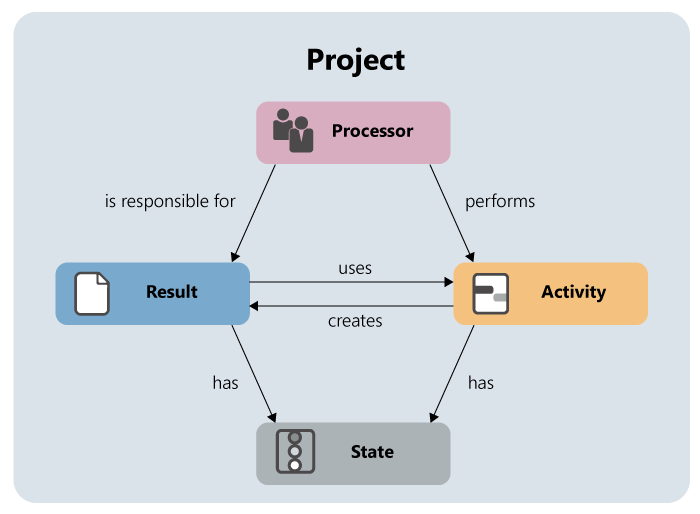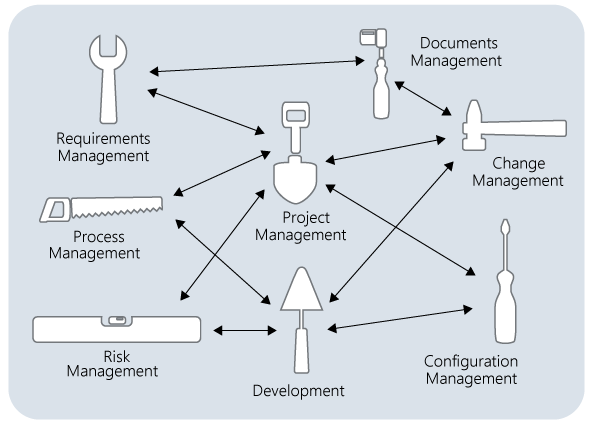Project Management Workflows. The Direct Path to Success.
How do you use workflows in your project management strategies? How to define your processes,
taking your infrastructure into account to manage your project with a single workflow?

Workflows consist of four elements: editors (roles), activities (tasks), results (products, artefacts) and states.
A project has editors that carry out activities in a specific order.
Activities produce results. A result may be a completed end product or an Excel sheet. Results then become the basis for subsequent activities.
Even if multiple editores are working on one result there should be one person responsible for the result.
In order for such a workflow to perform, results and activities must have states, e.g. in process or completed. This allows for date-related as well as content-related information on the progress of your project.
Workflow – a Definition
The term “workflow” describes the procedures involved in completing tasks – the defined sequence of steps required to produce results.
A workflow consists of four elements: actors (in some models this is set as a role), activity (sometimes called tasks), results (often desired products or artefacts) and state. So-called cardinalities are used to define how often particular results should be generated or how frequently tasks should be carried out. Can a document like a business case only exist once in a project? Perhaps, but not necessarily. Or can two business case documents be generated at the same time? These kind of questions need to be answered when workflows are being defined. Software can help to ensure that these kinds of prescriptions are adhered to.
A common Understanding of the Team Effort
Better Transparency
Improved Communication
Increased Quality and Efficiency
Categories of Workflows
There are two kinds of workflows:
- Firstly there are small, simple and logical workflows that only affect a few people. This kind of workflow does not require much attention – short verbal comments are enough for all participants to come to agreement, it is not necessary to have long meetings or to develop software systems. An example of this kind of workflow would be a two person project aimed at creating a website or booking conference rooms.
- Secondly, there are more complex workflows that affect several people in a project or a department for an extended period of time. This kind of workflow is often developed as a model and is documented so that it can be used as an example in a future endeavor. With these workflows often workflow management systems, process management systems or process-based project management tools come in handy. An example of this kind of workflow would be: The release of documents in projects that need to pass project audits or company endeavors in “controlled environments” such as travel, the automotive industry and the car delivery industry, the rail sector or the pharmaceutical industry.
Types of Workflows
There are various kinds of complex workflows:
- An activity is the most important part of an activity centered workflow, where editors with defined roles carry out activities and create results. There are often 1:1 relationships in this scenario; in other words, an activity would create a result and a partial activity which would create a partial result. The flow is defined by control flows in which the sequence of activities is set. Generally the end-beginning relationship (when A ends, B begins) is the standard. There is also a beginning sequence, i.e. a beginning-beginning relationship (when A begins, then B also begins), an end-end relationship (when A ends, then B also ends) or a leap sequence, i.e. beginning-ending (when A begins, B ends).
- A document centered- or results-oriented workflow focuses on results. Explicit activities for creating the results (in many projects these are often documents) are secondary to this approach. The sequence for creating results is defined by the product flows and conditions that are connected to the results.
Challenges in Workflows
There are different challenges in defining and using workflows:
Unpredictability – some things can’t be predicted in projects. Nor should they. Otherwise the level of detail and the scope of the workflow also need to be broader. When working with a workflow it’s important to note that unpredictable events can happen – necessitating a change in the workflow.
The Transparency – when working with a workflow you will be able to easily recognize which staff members are working on particular work packages and which staff members are waiting for specific work packages. This kind of transparency won’t be seen as an advantage by all staff members. It can lead to a desire in staff members to cover their own backs and pass the buck onto their colleagues.
Project Management in Practice
Learn more about project management with objectiF RPM here »
It’s important to define a workflow that supports the cooperation in the project and that also suits the project participants and employees.
How Do You Use Workflows in Project Management?
Some workflows won’t work with particular projects. The steps involved in building a house, developing a rocket or moving house are completely different. In order for you to organize projects with the right tools it is necessary to define project types. Each project type has a set workflow, possibly with several options for special challenges. And even if different companies are active in the same industry, their workflows will still differ because the activities will have been strongly influenced by their specific presiding culture, the form of communication prevalent there as well as the cooperation and the internal and external rules that govern interactions.

Infrastructure is an important aspect in working with workflows in project management. There are special solutions for many disciplines. Requirements are managed in a requirements software package while projects get planned using classic Gantt charts and project applications get maintained in a separate table. Is that the best solution? Or do you sometimes ask yourself the following questions?
- Who will look after the different interfaces between the tools for the interaction between the individual disciplines?
- How do you teach the users the many different tools, terms and operational functions?
- How will you automate the processes?
- ho is going to pay for it all?
